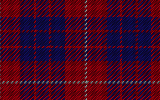HAMILTON HISTORY
HAMILTON PLACES
HAMILTON TARTANS
HAMILTONS IN THE U.S.
THOMAS HAMILTON
______________________
THE
CLAN SHAW
TAYLOR
FAMILY INDEX
![]()
EMAIL
SITE AUTHOR

| HAMILTON
MAIN
HAMILTON HISTORY HAMILTON PLACES HAMILTON TARTANS HAMILTONS IN THE U.S. THOMAS HAMILTON ______________________
|
 |
| The
Hamiltons
were the most important of the Lowland clans. The current Hamilton 'chief',
Angus
Douglas Hamilton, 15th Duke of Hamilton, is still the Premier Duke
of Scotland, the Hereditary Keeper of the Palace of Holyroodhouse and a
member of the Royal Company of Archers. At one time they aspired to the
crown itself, as serious rivals to the Stuarts. Though they did not lead
the same lifestyle as the Highland clans, their hereditary chiefship, network
of cadet houses with dependents, and their distinctive tartan make it clear
they were truly a Scottish Clan, with the sense of blood kinship and family
loyalties which are inseparable from this concept.
Since early in the 1300's, the Hamilton family has played a prominent part in Scottish history. It was a Hamilton who fought alongside Robert the Bruce at Bannockburn: a Hamilton who was heir to the Scottish throne in the 16th century and who arranged the marriage between Mary Queen of Scots and the Dauphin of France; and it was a Hamilton that Hess tried to contact by parachuting into Scotland during World War II. The first record of the family in Scotland was Sir Walter Fitz-Gilbertof Hameldone, an English knight that possessed properties in Renfrewshire. This first record is his name as a witness on a charter granted to the monastery of Paisley the privilege of a herring fishing in the Clyde. He was Governor of Bothwell Castle for the English during the early part of the Scottish War of Independence, but later joined Robert the Bruce and fought at his side at Bannockburn. For his support he was awarded forfeited Comyn lands by Bruce, including the properties of Cadzow in the Lothians that were in due course renamed Hamilton. It was here that he was to build Cadzow Castle and where eventually was to be built the magnificent Hamilton Palace - the grandest and most notable non-royal residence in all of Scotland. Sir Walter's son
Sir David, was captured by the English at the Battle of Neville's Cross
(also called the Battle of Durham), in company with his namesake, David
II, son of Bruce. Like the King, Hamilton was not released until a heavy
ransom had been paid. An even closer association with the royal house began
in about 1474 when James, 1st Lord Hamilton, married Princess Mary,
daughter of James II, King of Scots. Their son, James, the 2nd Lord
Hamilton, who inherited the title in 1479, was a nobleman of great accomplishment.
He took part in a naval expedition
 
 
SEE THE TARTAN LINK ON THE TOP LEFT In 1503, the 2nd Lord Hamilton was created Earl of Arran, the Gaelic-speaking island in the Forth of Clyde on which the family then made their home at Brodick Castle. Their son, the 2nd Earl, also called James, was the heir to the Scottish throne after King James IV and was named Regent, acting for Mary, Queen of Scots, during her minority. In this office he plundered royal revenues and, reportedly, played the English against the French for his own gain. After completing arrangements for the marriage of Mary to the Dauphin, he was rewarded by the French King, Henry II, with the grant of the French dukedom of Chatelherault. This gave the Duke great political power, as he was only the second person in Scotland, outside of a King;s son, to have a dukedom conferred on him. In 1561, after the Dauphin's death (by then Francis II), the 2nd Earl rebelled against the Queen's marriage to Darnley, but was pardoned on condition of being exiled for five years. Upon his return, he changed sides again and remained close to Mary. After her escape from Loch Leven she stayed at Cadzow Castle for some time in hiding along with, so it is said, the crown jewels. The 2nd Earl of Arran had two remarkable brothers, bastard sons of the 1st Earl. One, John Hamilton (c1511-1571) became Archbishop of St. Andrews. In this office he tried to reform the church from within, and issued a catechism in English. He baptized Queen Mary's son, the future King James VI, in 1566 and remained loyal to the Queen after her downfall. But when her brother, the Regent Moray was assassinated by a Hamilton, the party of Lennox hanged the Archbishop in his pontifical robes from a common gibbet. The royal connection continued to augment the family's fortune without other noticeable merit. The 3rd Earl of Arran became the 1st Marquess of Hamilton and the 3rd Marquess became the 1stDuke of Hamilton. James, the 3rd Marquess, was an inept man, not cut out for politics. However, he was very close to Charles I, who appointed him to several positions. Even though his stupidity and arrogance caused him to fail, Charles still appointed him as the 1st Duke of Hamilton in 1643. This dukedom is the oldest in Scotland and the third oldest in the Union. His inept manner, however, and attempts to steer the middle course, finally aroused the King's suspicions and he was imprisoned. Upon his release, he found that the King had been captured by Cromwell and immediately raised a Scottish army to rescue him. This was a remarkable show of loyalty to a man who had so recently imprisoned him. The Duke surrendered the army to Cornwell at Prestonin 1648 and in 1649, one month after his King, was beheaded at Whitehall. The 2nd Duke was the exact opposite of James. He was courageous, honest and highly intelligent. What would have been a brilliant career was cut short when he was killed at the Battle of Worcester at the age of 34. The line continued in the same manner with great and not so great Dukes. The 4th Duke was made the Duke of Brandon by Queen Anne in 1711, an additional title that all Dukes have carried to this day. His actions during the time of the Union are very suspect. It isn't surprising that he was killed while dueling with Lord Mohun in 1712. It was the 5th Duke that built the famed hunting lodge called Chatelherault, after the dukedom, on the grounds of Hamilton Palace. It was the 10th Duke, Alexander, that is possibly one of the most famous. It was he who turned Hamilton Palace into the most spectacular residence, filling it with priceless art and furniture. He was Ambassador to Czarist Russia and his great hero was Napoleon Bonaparte. His greatest triumph was the marriage of his son William, the 11th Duke, to Princess Marie of Baden, daughter of a cousin of Napoleon III. It was he that had the grandiose Hamilton Mausoleum built and reinterred the Hamilton ancestors there. |
\